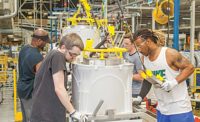Some 12,838,000 million Americans held manufacturing jobs in April 2019. That’s 12 percent more than in April 2010, it’s the highest total since December 2008. Overall, the U.S. unemployment rate fell to 3.6 percent in April 2019—the lowest jobless rate since December 1969.
As great as those numbers are, they could be even better. Talk to manufacturers anywhere in the country, and they’ll tell you their top challenge is the inability to attract skilled workers.
Minnesota manufacturers are no exception. More than 8,300 manufacturing companies are located in the North Star State, but they continue to lose talent to other fields like healthcare and high tech. To understand why, business and technology consulting firm West Monroe Partners polled 1,000 Minnesota workers aged 18 to 40. The results are thought-provoking.
While 70 percent of Minnesotans perceive the industry positively, 75 percent have never worked in manufacturing and 44 percent would not consider a career in manufacturing. Outside of compensation, respondents listed the following as the top things manufacturers could do to be more attractive places to work:
- Provide clearly defined career advancement opportunities (44 percent).
- Make the work environment safer (42 percent).
- Provide job security, even in the face of advances in automation (41 percent).
Fifty-six percent of Minnesotans say they would consider working in manufacturing, and this percentage increases if they were exposed to manufacturing careers through family members in the industry or through education during their youth.
Thirty-one percent have not worked in manufacturing because they do not have the right education or training. Minnesotans believe manufacturing companies are tech-forward, but the rise of automation holds them back from pursuing long-term careers in the industry. Three in four respondents think manufacturers use technology to its fullest potential, but Minnesotans are split as to whether that’s good or bad. Half think automation will replace jobs, but 48 percent also think it will create new job opportunities in areas like customer service, technology and engineering.
“Given the majority of the population doesn’t want to work in manufacturing, education about the benefits and changing digital environment needs to start early,” says Dennis McRae, leader of the firm’s consumer and industrial products industry team. “In fact, our poll showed Minnesotans who learned about manufacturing careers before they turned 18 were more likely to have a positive perception of the industry and consider launching a career there. That early education can be new trade programs focused on using advanced digital manufacturing technologies or involvement in the youth community at large.”
Manufacturers have done a lot to improve the perception of their industry in recent years. “Manufacturing Day” and other events have certainly helped. Clearly, more needs to be done.







